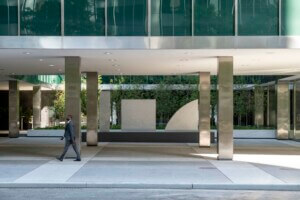In The Architect’s Newspaper April East edition, editor in chief William Menking broke the news that MoMA will be closing its architecture and design galleries. To continue the conversation, Menking sat down with Martino Stierli, the museum’s Philip Johnson Chief Curator of Architecture and Design.
The Architect’s Newspaper: As part of MoMA’s renovation of the current building, the collection galleries on the third floor of the museum, which include the architecture gallery, were closed over the course of the last few weeks. These galleries will reopen in a new configuration in early 2017. Can you explain that new configuration and how you believe the architecture and design collection (the museum calls them “medium designated”) will be better represented?
Martino Stierli: Indeed, as has been communicated earlier, the whole third floor is currently undergoing a renovation with the goal of having three bigger galleries that will have a variety of uses. One of the galleries has already undergone a slight conversion. That is the former design gallery in which we are currently showing A Japanese Constellation: Toyo Ito, SANAA, and Beyond. The other two new galleries on the third floor will open early next year. Going forward, all three of these galleries will be used for a variety of programs that include collection-based shows as well as special exhibitions.
With regard to your question about the galleries for the architecture and design collection, these will be located in the new building. Until this new wing opens—given that we are going to have less space throughout the renovation—we are going to have to be more flexible about how we make best use of our available spaces. This doesn’t mean, though, that we are not going to have any media-specific installations during this period. So for example, we are working on a collection-based exhibition called Interior Propositions, which is curated by Juliet Kinchin. This exhibition will be shown where we are currently presenting A Japanese Constellation. Immediately after that, in summer 2017, the same space will be part of the Frank Lloyd Wright exhibition, specifically for the education program. The main part of the exhibition will go into one of the new galleries, which will measure roughly 10,000 square feet. Having recently acquired the entire Frank Lloyd Wright Archives with Columbia University, that exhibition will again be overwhelmingly collection-based.
The Frank Lloyd Wright exhibition is an example of how we will be using spaces that have not previously been available for architecture and design collection shows. We’re also currently preparing an exhibition on the design of the early computer age that is going to go into a gallery on the second floor, traditionally [a space that] has been used for prints. Moreover, [associate curator] Sean Anderson is working on a collection-based exhibition on borders and migrations that will be presented in the Dunn Gallery on the second floor. The survey exhibition on the architecture of socialist Yugoslavia exhibition that I’m working on for the summer of 2018 will again go into the space on the third floor where the Frank Lloyd Wright show will be presented next summer. So one could say that a certain continuity on the third floor will be ensured. At the same time, exhibitions organized by other curatorial departments will also be shown on that floor.
So, because the museum is going to be larger with the new addition, it’s still not worked out where things are going to go.
That is correct. The new buildings will not open before 2019, and we are still working intensely on figuring out how the new spaces will be configured and what will go where. While we have not finalized the specific locations for the different parts
of our various collections, we are committed to medium-dedicated galleries.
As far as the next few years are concerned, during the renovation and expansion projects, we will have to operate with more flexibility simply because we won’t have the same square footage available throughout the museum. Nevertheless, we are fully
committed to presenting our rich collection in a way that will do justice to the specific needs of each medium, including architecture and design, while making visible the many meaningful connections among the different arts. It is a strategy that we think of as both/and: We are committed to both medium-dedicated galleries and more broadly comprehensive ones. There is no change in policy in this regard and the abolishing of architecture and design designated galleries is not and never has been an issue under consideration.
What you’re saying is that, in 2019, when all this opens up, there will be medium-designated galleries?
Yes. I can’t tell you at the moment what these galleries will look like specifically, simply because we are still very much working on these questions. But there will be medium-designated spaces.
If the departments of architecture and design will no longer have any dedicated exhibition spaces, the fear is that this collection will openly serve as a background to the other arts like painting and sculpture. You seem confident that this will not happen.
Yes. At the same time, I also want to say that I am interested in experimenting with new forms of displaying our collections and to see how far we can go in affording a more comprehensive look of the history of modernism. The exhibition on the fourth floor that deals with the 1960s is an example of this kind of experimentation, but it would be wrong to assume that this will be a model for other shows going forward that will also take a more comprehensive approach than we have traditionally done.
I agree with your belief that architecture is an art on the same level as painting, sculpture, and photography, but don’t you think, because of its necessity to be created collaboratively in a workshop, or needing to sometimes surrender to the wishes of the patron or client, or need to consider structural necessities, that architecture has its own requirements that can only be explored in a dedicated gallery? Doesn’t architecture also benefit from a gallery dedicated exclusively to its own medium?
Yes, I absolutely agree, and hence I believe it is important to have a space at hand in which the narratives specific to modern architecture and design can be explored.
Do you have plans to display the museum’s enormous collection of nearly 200,000 architecture and design objects? Many of these will not qualify as great major works, but are nevertheless important to the understanding of the museum.
Several of the exhibitions that I mentioned earlier are actually collection shows: Interior Propositions is a collection show. Frank Lloyd Wright is a collection show. The Borders and Migrations show is mainly a collection-based show, even though it
will include some loans. The computer age design exhibition is also a collection show. And after the expansion opens, we’ll have much more space to show the collection. The whole idea of this expansion project is to have more space for our amazing collection.
How much more square footage are you getting?
50,000 more square feet and a 30 percent increase in gallery space. We will still only be able to present a fraction of the collection at one time, but it will be significantly more than before.










